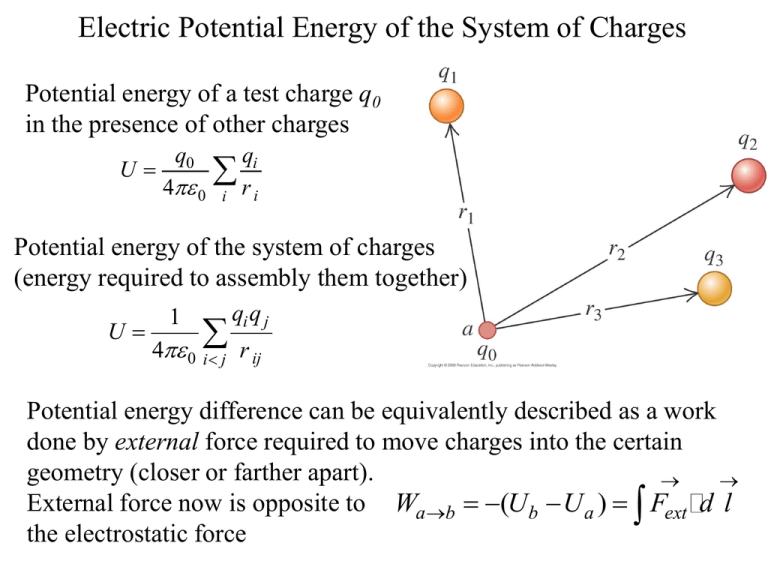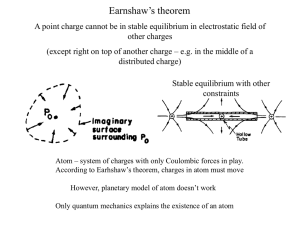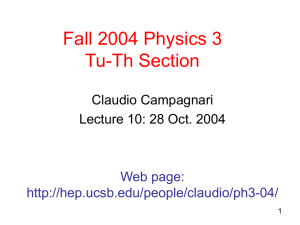PHYS_2326_020309
advertisement

Electric Potential Energy of the System of Charges Potential energy of a test charge q0 in the presence of other charges U q0 qi 4 0 i r i Potential energy of the system of charges (energy required to assembly them together) U 1 qi q j 4 0 i j r ij Potential energy difference can be equivalently described as a work done by external force required to move charges into the certain geometry (closer or farther apart). External force now is opposite to Wa b (U b U a ) Fext d l the electrostatic force Electric Potential Energy of System • The potential energy of a system of two point charges q1q2 U ke r12 • If more than two charges are present, sum the energies of every pair of two charges that are present to get the total potential energy U total ke i, j qi q j rij q1q2 q1q3 q2 q3 U total ke r13 r23 r12 Electric potential is electric potential energy per unit charge Finding potential (a scalar) is often much easier than the field (which is a vector). Afterwards, we can find field from a potential U V q0 Units of potential are Volts [V] 1 Volt=1Joule/Coulomb If an electric charge is moved by the electric field, the work done by the field Wa b U (Va Vb ) q0 q0 Potential difference if often called voltage Two equivalent interpretations of voltage: 1.Vab is the potential of a with respect to b, equals the work done by the electric force when a UNIT charge moves from a to b. 2. Vab is the potential of a with respect to b, equals the work that must be done to move a UNIT charge slowly from b to a against the electric force. Potential due to the point charges 1 dq V 4 0 r Potential due to a continuous distribution of charge Finding Electric Potential through Electric Field b Wa b Va Vb E d l q0 a Some Useful Electric Potentials • For a uniform electric field r r r V E dl E • For a point charge q V ke r • For a series of point charges qi V ke ri r r r dl E l Potential of a point charge Moving along the E-field lines means moving in the direction of decreasing V. As a charge is moved by the field, it loses it potential energy, whereas if the charge is moved by the external forces against the E-field, it acquires potential energy • Negative charges are a potential minimum • Positive charges are a potential maximum Positive Electric Charge Facts • For a positive source charge – Electric field points away from a positive source charge – Electric potential is a maximum – A positive object charge gains potential energy as it moves toward the source – A negative object charge loses potential energy as it moves toward the source Negative Electric Charge Facts • For a negative source charge – Electric field points toward a negative source charge – Electric potential is a minimum – A positive object charge loses potential energy as it moves toward the source – A negative object charge gains potential energy as it moves toward the source Electron Volts Electron volts – units of energy U eVab 1 eV – energy a positron (charge +e) receives when it goes through the potential difference Vab =1 V Unit: 1 Volt= 1 Joule/Coulomb (V=J/C) Field: N/C=V/m 1 eV= 1.6 x 10-19 J Just as the electric field is the electric force per unit charge, the electrostatic potential is the potential energy per unit charge. Examples A small particle has a charge -5.0 mC and mass 2*10-4 kg. It moves from point A, where the electric potential is fa =200 V and its speed is V0=5 m/s, to point B, where electric potential is fb =800 V. What is the speed at point B? Is it moving faster or slower at B than at A? E 2 2 A B F mV0 mV qa qb 2 2 Vb ~ 7.4 m / s In Bohr’s model of a hydrogen atom, an electron is considered moving around a stationary proton in a circle of radius r. Find electron’s speed; obtain expression for electron’s energy; find total energy. 11 e2 V2 r 5.3 10 m U Fe ke 2 m K r r 2 T 13.6 eV T K U Calculating Potential from E field • To calculate potential function from E field V f i r r E ds (E x iˆ E y ˆj E z kˆ ) dxiˆ dyˆj dzkˆ f i f i E x dx E y dy E z dz When calculating potential due to charge distribution, we calculate potential explicitly if the exact distribution is known. If we know the electric field as a function of position, we integrate the field. b E d l a Generally, in electrostatics it is easier to calculate a potential (scalar) and then find electric field (vector). In certain situation, Gauss’s law and symmetry consideration allow for direct field calculations. Moreover, if applicable, use energy approach rather than calculating forces directly (dynamic approach) Example: Solid conducting sphere Outside: Potential of the point charge 1 q V 4 0 r Inside: E=0, V=const Potential of Charged Isolated Conductor • The excess charge on an isolated conductor will distribute itself so all points of the conductor are the same potential (inside and surface). • The surface charge density (and E) is high where the radius of curvature is small and the surface is convex • At sharp points or edges (and thus external E) may reach high values. • The potential in a cavity in a conductor is the same as the potential throughout the conductor and its surface At the sharp tip (r tends to zero), large electric field is present even for small charges. Lightning rod – has blunt end to allow larger charge Corona – glow of air due to gas discharge built-up – higher probability near the sharp tip. Voltage breakdown of of a lightning strike the air Vmax 3 10 6 V /m Vmax REmax Example: Potential between oppositely charged parallel plates From our previous examples U ( y ) q0 Ey V ( y ) Ey Vab E d Easy way to calculate surface charge density 0Vab d Remember! Zero potential doesn’t mean the conducting object has no charge! We can assign zero potential to any place, only difference in potential makes physical sense Calculating E field from Potential • Remembering E is perpendicular to equipotential surfaces E V V ˆ V ˆ V ˆ E i j k y z x V V V Ex Ey Ez x y z Example: Charged wire We already know E-field around the wire only has a radial component b 1 rb ln Er ; E dr 2 0 ra 2 0 r a Vb = 0 – not a good choice as it follows Va Why so? We would want to set Vb = 0 at some distance r0 from the wire r - some distance from the wire r0 V ln 2 0 r Example: Sphere, uniformly charged inside through volume r q Q R R 3 ' E Q - volume density of charge V r 3 0 R ( r R) r R r E dr 2 R keQ r r R 3 |R R 2 keQ R R Q - total charge keQ r2 r 3 2 2R R This is given that at infinity 0









